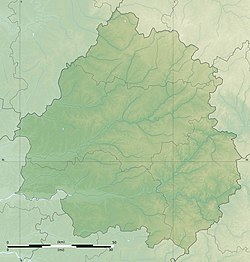Lascaux
| UNESCO World Heritage Site | |
|---|---|
 Depiction of aurochs, horses and deer | |
| Location | Montignac, France |
| Part of | Prehistoric Sites and Decorated Caves of the Vézère Valley |
| Criteria | Cultural: i, iii |
| Reference | 85-011 |
| Inscription | 1979 (3rd Session) |
| Area | 34.34 ha (84+7⁄8 acres) |
| Coordinates | 45°03′13″N 1°10′12″E / 45.05361°N 1.17000°E |
| Lascaux | |
|---|---|
 | |
| Coordinates | 45°03′13″N 1°10′12″E / 45.05361°N 1.17000°E |
Lascaux (English: /læˈskoʊ/ la-SKOH,[1] US also /lɑːˈskoʊ/ lah-SKOH;[2] French: Grotte de Lascaux [ɡʁɔt də lasko],[3] "Lascaux Cave") is a network of caves near the village of Montignac, in the department of Dordogne in southwestern France. Over 600 parietal wall paintings cover the interior walls and ceilings of the cave. The paintings represent primarily large animals, typical local contemporary fauna that correspond with the fossil record of the Upper Paleolithic in the area. They are the combined effort of many generations. With continued debate, the age of the paintings is now usually estimated at around 17,000 - 22,000 years (early Magdalenian).[4][5][6] Because of the outstanding prehistoric art in the cave, Lascaux was inducted into the UNESCO World Heritage List in 1979, as an element of the Prehistoric Sites and Decorated Caves of the Vézère Valley.[7]
The original caves have been closed to the public since 1963, as their condition was quickly deteriorating, but there are now a number of replicas.
History since rediscovery
[edit]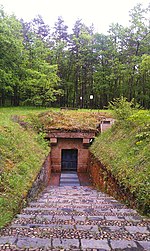
On 12 September 1940, the entrance to the Lascaux Cave was discovered on the La Rochefoucauld-Montbel lands by 18-year-old Marcel Ravidat when his dog, Robot, investigated a hole left by an uprooted tree (Ravidat would embellish the story in later retellings, saying Robot had fallen into the cave.)[8][9] Ravidat returned to the scene with three friends, Jacques Marsal, Georges Agnel, and Simon Coencas. They entered the cave through a 15-metre-deep (50-foot) shaft that they believed might be a legendary secret passage to the nearby Lascaux Manor.[9][10][11] The teenagers discovered that the cave walls were covered with depictions of animals.[12][13] Galleries that suggest continuity, context or simply represent a cavern were given names. Those include the Hall of the Bulls, the Passageway, the Shaft, the Nave, the Apse, and the Chamber of Felines. They returned along with the Abbé Henri Breuil on 21 September 1940; Breuil would make many sketches of the cave, some of which are used as study material today due to the extreme degradation of many of the paintings. Breuil was accompanied by Denis Peyrony, curator of Les eyzies (Prehistory Museum) at Les Eyzies, Jean Bouyssonie and Dr Cheynier.
The cave complex was opened to the public on 14 July 1948, and initial archaeological investigations began a year later, focusing on the Shaft. By 1955, carbon dioxide, heat, humidity, and other contaminants produced by 1,200 visitors per day had visibly damaged the paintings. As air condition deteriorated, fungi and lichen increasingly infested the walls. Consequently, the cave was closed to the public in 1963, the paintings were restored to their original state, and a monitoring system on a daily basis was introduced.
Replicas
[edit]
Conservation problems in the original cave have made the creation of replicas more important.
Lascaux II
[edit]Lascaux II, an exact copy of the Great Hall of the Bulls and the Painted Gallery was displayed at the Grand Palais in Paris, before being displayed from 1983 in the cave's vicinity (about 200 m or 660 ft away from the original cave), a compromise and attempt to present an impression of the paintings' scale and composition for the public without harming the originals.[10][13] A full range of Lascaux's parietal art is presented a few kilometres from the site at the Centre of Prehistoric Art, Le Parc du Thot, where there are also live animals representing ice-age fauna.[14]
The paintings for this site were duplicated with the same type of materials (such as iron oxide, charcoal, and ochre) which were believed to be used 19,000 years ago.[9][15][16][17] Other facsimiles of Lascaux have also been produced over the years.
Lascaux III
[edit]Lascaux III is a series of five exact reproductions of the cave art (the Nave and Shaft) that, since 2012, have been exhibited in various countries, allowing knowledge of Lascaux to be shared widely, far away from the original.
Lascaux IV
[edit]Lascaux IV is the latest replica, in real scale, of the integrality of the cave of Lascaux. Situated on the same hill overlooking Montignac,[18] and 400 m from the original site, it is part of the International Centre for Parietal Art (Centre International de l'Art Pariétal) that was inaugurated in December 2016. The museum, built by Snøhetta,[19] integrates digital technology, workshops and films into adjacent display rooms.
Geographic setting
[edit]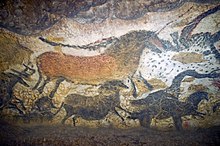
In its sedimentary composition, the Vézère drainage basin covers one fourth of the département of the Dordogne, the northernmost region of the Black Périgord. Before joining the Dordogne River near Limeuil, the Vézère flows in a south-westerly direction. At its centre point, the river's course is marked by a series of meanders flanked by high limestone cliffs that determine the landscape. Upstream from this steep-sloped relief, near Montignac and in the vicinity of Lascaux, the contours of the land soften considerably; the valley floor widens, and the banks of the river lose their steepness.
The Lascaux valley is located some distance from the major concentrations of decorated caves and inhabited sites, most of which were discovered further downstream.[20] In the environs of the village of Eyzies-de-Tayac Sireuil, there are no fewer than 37 decorated caves and shelters, as well as an even greater number of habitation sites from the Upper Paleolithic, located in the open, beneath a sheltering overhang, or at the entrance to one of the area's karst cavities. This is the highest concentration in Europe.
Images
[edit]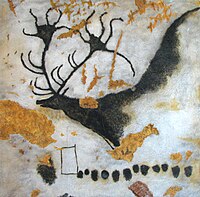
The cave contains nearly 6,000 figures, which can be grouped into three main categories: animals, human figures, and abstract signs. The paintings contain no images of the surrounding landscape or the vegetation of the time.[20] Most of the major images have been painted onto the walls using red, yellow, and black colours from a complex multiplicity of mineral pigments[21]: 110 [22] including iron compounds such as iron oxide (ochre),[23]: 204 hematite, and goethite,[22][24] as well as manganese-containing pigments.[22][23]: 208 Charcoal may also have been used[23]: 199 but seemingly to a sparing extent.[21] On some of the cave walls, the colour may have been applied as a suspension of pigment in either animal fat or calcium-rich cave groundwater or clay, making paint,[21] that was swabbed or blotted on, rather than applied by brush.[24] In other areas, the colour was applied by spraying the pigments by blowing the mixture through a tube.[24] Where the rock surface is softer, some designs have been incised into the stone. Many images are too faint to discern, and others have deteriorated entirely.
Over 900 can be identified as animals, and 605 of these have been precisely identified. Out of these images, there are 364 paintings of equines as well as 90 paintings of stags. Also represented are cattle and bison, each representing 4 to 5% of the images. A smattering of other images includes seven felines, a bird, a bear, a rhinoceros. In the deepest reaches of the cave, at the bottom of a 9m-deep well, the only human figure of the cave was depicted, in a strikingly different style. There are no images of reindeer, even though that was the principal source of food for the artists, and no image of fish either.[25] Geometric images have also been found on the walls.
The most famous section of the cave is The Hall of the Bulls where bulls, equines, aurochs, stags, and the only bear in the cave are depicted. The four black bulls, or aurochs, are the dominant figures among the 36 animals represented here. One of the bulls is 5.2 metres (17 ft 1 in) long, the largest animal discovered so far in cave art. Additionally, the bulls appear to be in motion.[25]
A painting referred to as "The Crossed Bison", found in the chamber called the Nave, is often submitted as an example of the skill of the Paleolithic cave painters. The crossed hind legs create the illusion that one leg is closer to the viewer than the other. This visual depth in the scene, enhanced by the three dimensional structure of the painted rock, demonstrates a highly sophisticated form of perspective which disappeared with the Magdalenian culture and would not re-emerge until the Italian Renaissance.[26] As famously quoted by Picasso upon encountering paleolithic art: "we have learned nothing in twelve thousand years".
Parietal representation
[edit]The Hall of the Bulls presents the most spectacular composition of Lascaux. Its calcite walls are not suitable for engraving, so it is only decorated with paintings, often of impressive dimensions: some are up to five metres long.
Two rows of aurochs face each other, two on one side and three on the other. The two aurochs on the north side are accompanied by about ten horses and a large enigmatic animal, with two straight lines on its forehead that earned it the nickname "unicorn". On the south side, three large aurochs are next to three smaller ones, painted red, as well as six small deer and the only bear in the cave, superimposed on the belly of an aurochs and difficult to read.
The Axial Diverticulum is also decorated with cattle and horses accompanied by deer and ibex. A drawing of a fleeing horse was brushed with manganese pencil 2.50 metres above the ground. Some animals are painted on the ceiling and seem to roll from one wall to the other. These representations, which required the use of scaffolding, are intertwined with many signs (sticks, dots, and rectangular signs).
The Passage has a highly degraded decoration, notably through air circulation.
The Nave has four groups of figures: the Empreinte panel, the Black Cow panel, the Deer swimming panel, and the Crossed Buffalo panel. These works are accompanied by many enigmatic geometric signs, including coloured checkers that H. Breuil called "coats of arms".
The Feline Diverticulum owes its name to a group of felines, one of which seems to urinate to mark its territory. Very difficult to access, one can see there engravings of wild animals of a rather naive style. There are also other animals associated with signs, including a representation of a horse seen from the front, exceptional in Paleolithic art where animals are generally represented in profiles or from a "twisted perspective".
The Apse contains more than a thousand engravings, some of which are superimposed on paintings, corresponding to animals and signs. There is the only reindeer represented in Lascaux.
The Well presents the most enigmatic scene of Lascaux: an ithyphallic man with a bird's head seems to lie on the ground, perhaps knocked down by a buffalo gutted by a spear; at his side is represented an elongated object surmounted by a bird, on the left a rhinoceros moves away. Various interpretations of what is represented have been offered.[27] A horse is also present on the opposite wall. Two groups of signs are to be noted in this composition:
- between man and rhinos, three pairs of digitized punctuation marks found at the bottom of the Cat Diverticulum, in the most remote part of the cave;
- under man and bison, a complex barbed sign that can be found almost identically on other walls of the cave, and also on paddle points and on the sandstone lamp found nearby.
Interpretation
[edit]The interpretation of Palaeolithic Art is problematic, as it can be influenced by our own prejudices and beliefs. Some anthropologists and art historians theorize the paintings could be an account of past hunting success, or could represent a mystical ritual in order to improve future hunting endeavors. The latter theory is supported by the overlapping images of one group of animals in the same cave location as another group of animals, suggesting that one area of the cave was more successful for predicting a plentiful hunting excursion.[28]
Applying the iconographic method of analysis to the Lascaux paintings (studying position, direction and size of the figures; organization of the composition; painting technique; distribution of the color planes; research of the image center), Thérèse Guiot-Houdart attempted to comprehend the symbolic function of the animals, to identify the theme of each image and finally to reconstitute the canvas of the myth illustrated on the rock walls.[29][further explanation needed]

Julien d'Huy and Jean-Loïc Le Quellec showed that certain angular or barbed signs of Lascaux may be analysed as "weapon" or "wounds". These signs affect dangerous animals – big cats, aurochs, and bison – more than others and may be explained by a fear of the animation of the image.[30] Another finding supports the hypothesis of half-alive images. At Lascaux, bison, aurochs, and ibex are not represented side by side. Conversely, one can note a bison-horses-lions system and an aurochs-horses-deer-bears system, these animals being frequently associated.[31] Such a distribution may show the relationship between the species pictured and their environmental conditions. Aurochs and bison fight one against the other, and horses and deer are very social with other animals. Bison and lions live in open plains areas; aurochs, deer and bears are associated with forests and marshes; ibex habitat is rocky areas, and horses are highly adaptive for all these areas. The Lascaux paintings' disposition may be explained by a belief in the real life of the pictured species, wherein the artists tried to respect their real environmental conditions.[32]
Less known is the image area called the Abside (Apse), a roundish, semi-spherical chamber similar to an apse in a Romanesque basilica. It is approximately 4.5 metres in diameter (about 5 yards) and covered on every wall surface (including the ceiling) with thousands of entangled, overlapping, engraved drawings.[33] The ceiling of the Apse, which ranges from 1.6 to 2.7 metres high (about 5.2 to 8.9 feet) as measured from the original floor height, is so completely decorated with such engravings that it indicates that the prehistoric people who executed them first constructed a scaffold to do so.[20][34]
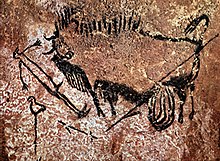
According to David Lewis-Williams and Jean Clottes who both studied presumably similar art of the San people of Southern Africa, this type of art is spiritual in nature relating to visions experienced during ritualistic trance-dancing. These trance visions are a function of the human imagination and so are independent of geographical location.[35] Nigel Spivey, a professor of classical art and archeology at the University of Cambridge, has further postulated in his series, How Art Made the World, that dot and lattice patterns overlapping the representational images of animals are very similar to hallucinations provoked by sensory-deprivation. He further postulates that the connections between culturally important animals and these hallucinations led to the invention of image-making, or the art of drawing.[36]
André Leroi-Gourhan studied the cave from the 1960s; his observation of the associations of animals and the distribution of species within the cave led him to develop a Structuralist theory that posited the existence of a genuine organization of the graphic space in Palaeolithic sanctuaries. This model is based on a masculine/feminine duality – which can be particularly observed in the bison/horse and aurochs/horse pairs – identifiable in both the signs and the animal representations. He also defined an ongoing evolution through four consecutive styles, from the Aurignacian to the Late Magdalenian. Leroi-Gourhan did not publish a detailed analysis of the cave's figures. In his work Préhistoire de l'art occidental, published in 1965, he nonetheless put forward an analysis of certain signs and applied his explanatory model to the understanding of other decorated caves.
Threats
[edit]
The opening of Lascaux Cave after World War II changed the cave environment. The exhalations of 1,200 visitors per day, presence of light, and changes in air circulation have created a number of problems. Lichens and crystals began to appear on the walls in the late 1950s, leading to closure of the caves in 1963. This led to restriction of access to the real caves to a few visitors every week, and the creation of a replica cave for visitors to Lascaux. In 2001, the authorities in charge of Lascaux changed the air conditioning system which resulted in regulation of the temperature and humidity. When the system had been established, an infestation of Fusarium solani, a white mold, began spreading rapidly across the cave ceiling and walls.[37] The mold is considered to have been present in the cave soil and exposed by the work of tradesmen, leading to the spread of the fungus which was treated with quicklime. In 2007, a new fungus, which has created grey and black blemishes, began spreading in the real cave.
As of 2008, the cave contained black mold. In January 2008, authorities closed the cave for three months, even to scientists and preservationists. A single individual was allowed to enter the cave for twenty minutes once a week to monitor climatic conditions. Now only a few scientific experts are allowed to work inside the cave and just for a few days a month, but the efforts to remove the mold have taken a toll, leaving dark patches and damaging the pigments on the walls.[38] In 2009 the mold problem was pronounced stable.[39] In 2011 the fungus seemed to be in retreat after the introduction of an additional, even stricter conservation program.[40] Two research programs have been instigated at the CIAP concerning how to best treat the problem, and the cave also now possesses a climatisation system designed to reduce the introduction of bacteria.
Organized through the initiative of the French Ministry of Culture, an international symposium titled "Lascaux and Preservation Issues in Subterranean Environments" was held in Paris on 26 and 27 February 2009, under the chairmanship of Jean Clottes. It brought together nearly three hundred participants from seventeen countries with the goal of confronting research and interventions conducted in Lascaux Cave since 2001 with the experiences gained in other countries in the domain of preservation in subterranean environments.[41] The proceedings of this symposium were published in 2011. Seventy-four specialists in fields as varied as biology, biochemistry, botany, hydrology, climatology, geology, fluid mechanics, archaeology, anthropology, restoration and conservation, from numerous countries (France, United States, Portugal, Spain, Japan, and others) contributed to this publication.[42]
In May 2018 Ochroconis lascauxensis, a species of fungus of the Ascomycota phylum, was officially described and named after the place of its first emergence and isolation, the Lascaux cave. This followed on from the discovery of another closely related species Ochroconis anomala, first observed inside the cave in 2000. The following year black spots began to appear among the cave paintings. No official announcement on the effect or progress of attempted treatments has ever been made.[43]
The problem is ongoing, as are efforts to control the microbial and fungal growths in the cave. The fungal infection crises have led to the establishment of an International Scientific Committee for Lascaux and to rethinking how, and how much, human access should be permitted in caves containing prehistoric art.[44]
See also
[edit]References
[edit]- ^ "American English Dictionary: Definition of Lascaux". Collins. Archived from the original on 27 September 2013. Retrieved 18 August 2013.
- ^ "Lascaux". Lexico US English Dictionary. Oxford University Press. Archived from the original on 16 April 2021.
- ^ "English Dictionary: Definition of Lascaux". Collins. Archived from the original on 27 September 2013. Retrieved 18 August 2013.
- ^ "Lascaux Cave Paintings: Layout, Meaning, Photographs – Dating – Chronological questions about the age of Lascaux's cave paintings, over what period they were created, and the identity of the oldest art in the complex, are still being debated..." Visual arts cork com. Archived from the original on 30 December 2016. Retrieved 28 December 2016.
- ^ "Ice Age star map discovered – thought to date back 16,500 years". BBC. 9 August 2000. Archived from the original on 18 April 2020. Retrieved 27 December 2016.
- ^ Lascaux, France. These paintings are estimated to be around 17,300 years old. Ancient-wisdom. 2000. Archived from the original on 28 December 2016. Retrieved 27 December 2016.
- ^ "Prehistoric Sites and Decorated Caves of the Vézère Valley". UNESCO World Heritage Centre. Archived from the original on 7 October 2019. Retrieved 30 December 2012.
- ^ Curtis, Gregory (2007). The Cave Painters. Anchor Books. pp. 82–88. ISBN 978-1-4000-7887-5.
- ^ a b c "Lascaux's prehistoric cave of wonders discovered by a dog". www.dailytelegraph.com.au. 10 September 2015. Retrieved 21 December 2018.
- ^ a b "Lascaux Cave". World History Encyclopedia. Archived from the original on 25 April 2023. Retrieved 21 December 2018.
- ^ "Discovery of the Lascaux Cave Paintings | History Today". www.historytoday.com. Archived from the original on 21 December 2018. Retrieved 21 December 2018.
- ^ Thomas, Robert McG. Jr. (31 March 1995). "Marcel Ravidat is Dead at 72; Found Lascaux Paintings". The New York Times. Archived from the original on 25 December 2022. Retrieved 30 December 2012.
- ^ a b Bahn, Paul G. (2007). Cave Art: A Guide to the Decorated Ice Age Caves of Europe. London: Frances Lincoln. pp. 81–85. ISBN 978-0-7112-2655-5.
- ^ "le retour des loups "préhistoriques"". Archived from the original on 4 December 2022. Retrieved 17 June 2017.
- ^ Hirst, Kris. "The Beautiful and Famous Lascaux Cave". ThoughtCo. Archived from the original on 1 April 2023. Retrieved 21 December 2018.
- ^ "Lectures on the Ice-Age Painted Caves of Southwestern France" (PDF). Archived (PDF) from the original on 12 December 2022. Retrieved 21 December 2018.
- ^ Ferrier, Catherine; Debard, Évelyne; Kervazo, Bertrand; Brodard, Aurélie; Guibert, Pierre; Baffier, Dominique; Feruglio, Valérie; Gély, Bernard; Geneste, Jean-Michel (28 December 2014). "Heated walls of the cave Chauvet-Pont d'Arc (Ardèche, France): characterization and chronology". PALEO. Revue d'archéologie préhistorique (25): 59–78. doi:10.4000/paleo.3009. ISSN 1145-3370. S2CID 192897888. Archived from the original on 1 February 2023. Retrieved 21 December 2018.
- ^ Lascaux IV International Centre for Cave Art Archived 24 April 2023 at the Wayback Machine, official website.
- ^ Lascaux IV: The International Centre for Cave Art Archived 6 March 2023 at the Wayback Machine, Snøhetta projects, website snohetta.com
- ^ a b c Nechvatal, Joseph (2011). Immersion into Noise. Ann Arbor: Open Humanities Press. pp. 74–76. ISBN 978-1-60785-241-4. Archived from the original on 17 November 2015. Retrieved 30 December 2012.
- ^ a b c Dickson, D. Bruce (1992). The Dawn of Belief: Religion in the Upper Paleolithic of Southwestern Europe. University of Arizona Press. ISBN 0-8165-1336-8. Archived from the original on 1 June 2024. Retrieved 25 September 2020.
- ^ a b c Chalmin E, Farges F, Vignaud C, et al. Discovery of Unusual Minerals in Paleolithic Black Pigments from Lascaux (France) and Ekain (Spain) Archived 1 June 2024 at the Wayback Machine.
- ^ a b c Rapp, George R. (2013). Archaeomineralogy. Springer. ISBN 978-3-662-05005-7. Archived from the original on 1 June 2024. Retrieved 25 September 2020.
- ^ a b c "Lascaux Cave Paintings: Layout, Meaning, Photographs". visual-arts-cork.com. Archived from the original on 30 December 2016. Retrieved 24 January 2016.
- ^ a b Curtis, Gregory (2006). The Cave Painters: Probing the Mysteries of the World's First Artists (1st ed.). New York: Alfred A. Knopf. pp. 96–97, 102. ISBN 1-4000-4348-4.
- ^ {https://www.vulture.com/2015/01/most-powerful-artwork-i-have-ever-seen.html}
- ^ Eshleman, Clayton, Juniper Fuse: Upper Paleolithic Imagination & the Construction of the Underworld, pp. 35–36, 2003, Wesleyan University Press, ISBN 0-8195-6605-5, google books Archived 19 April 2024 at the Wayback Machine
- ^ "Lascaux cave: History". www.karstworlds.com. Archived from the original on 27 November 2018. Retrieved 26 November 2018.
- ^ Guiot-Houdart, Thérèse (2004). Lascaux et les mythes (in French). Périgueux: Pilote 24. ISBN 2-912347-39-4.
- ^ Julien d'Huy et Jean-Loïc Le Quellec (2010). "Les animaux 'fléchés' à Lascaux: nouvelle proposition d’interprétation" Archived 1 February 2012 at the Wayback Machine Préhistoire du Sud-Ouest 18(2): 161–170
- ^ Denis Tauxe (2007)."L’organisation symbolique du dispositif pariétal de la grotte de Lascaux", Préhistoire du Sud-Ouest, 15: 177–266
- ^ Julien d'Huy (2011). "La distribution des animaux à Lascaux reflèterait leur distribution naturelle Archived 1 February 2012 at the Wayback Machine", Bulletin de la Société Historique et Archéologique du Périgord CXXXVIII, 493–502
- ^ Leroi-Gourhan, André. The Art of Prehistoric Man in Western Europe. London: Thames and Hudson. 1968. p. 315
- ^ Mario Ruspoli, The Cave of Lascaux: The Final Photographic Record (New York: Abrams, 1983) pp. 146–147
- ^ Harry Francis Mallgrave (2013). Architecture and Embodiment: The Implications of the New Sciences and Humanities for Design. Routledge. pp. 190–. ISBN 978-1-135-09424-9.
- ^ Gray, S.W. (2014). "The cartographic paradigm in contemporary Australian landscape painting". Archived from the original on 12 September 2021. Retrieved 25 May 2020.
- ^ Joëlle Dupont; Claire Jacquet; Bruno Dennetière; Sandrine Lacoste (2007). "Invasion of the French Paleolithic painted cave of Lascaux by members of the Fusarium solani species complex". Mycologia. 99 (4): 526–533. doi:10.3852/mycologia.99.4.526. PMID 18065003.
- ^ Moore, Molly (1 July 2008). "Debate Over Moldy Cave Art Is a Tale of Human Missteps". The Washington Post. Retrieved 30 December 2012.
- ^ Saiz-Jimenez, C. (24 October 2014). The Conservation of Subterranean Cultural Heritage. CRC Press. ISBN 978-0-429-22693-9. Archived from the original on 15 January 2020. Retrieved 15 January 2020.
- ^ "Lascaux's 18,000-year-old cave art under threat". Phys.org. Archived from the original on 28 December 2016. Retrieved 28 December 2016.
- ^ At the Takamatsuzuka Tomb in Japan, and Altamira in Spain, for example.
- ^ Coye, N. dir. (2011), Lascaux et la conservation en milieu souterrain: actes du symposium international (Paris, 26–27 fév. 2009) = Lascaux and Preservation Issues in Subterranean Environments: Proceedings of the International Symposium Archived 1 November 2012 at the Wayback Machine (Paris, 26 and 27 February), Éditions de la Maison des sciences de l'homme, 360 p. In French and English.
- ^ Martin-Sanchez, Pedro Maria; Nováková, Alena; Bastian, Fabiola; Alabouvette, Claude; Saiz-Jimenez, Cesareo (2012). "Two new species of the genus Ochroconis, O. lascauxensis and O. anomala isolated from black stains in Lascaux Cave, France". Fungal Biology. 116 (5). Elsevier: 574–89. doi:10.1016/j.funbio.2012.02.006. PMID 22559918.
- ^ Simons, Marlise (9 December 2007). "Fungus Once Again Threatens French Cave Paintings". The New York Times. Archived from the original on 12 May 2013. Retrieved 15 October 2010.
Further reading
[edit]- Dubowski, Mark (2010). Discovery in the Cave (Children's early reader). New York: Random House. ISBN 978-0-375-85893-2.
- Curtis, Gregory (2006). The Cave Painters: Probing the Mysteries of the World's First Artists. New York: Knopf. ISBN 1-4000-4348-4.
- Lewis-Williams, David (2004). The Mind in the Cave: Consciousness and the Origins of Art. Thames and Hudson. ISBN 0-500-28465-2.
- Bataille, Georges (2005). The Cradle of Humanity: Prehistoric Art and Culture. New York: Zone Books. ISBN 1-890951-55-2.
- — (1980) Prehistoric Painting: Lascaux or the Birth of Art. Trans. Austryn Wainhouse. Geneva: Skira [first published, 1955].
- Joseph Nechvatal, Immersive Excess in the Apse of Lascaux, Technonoetic Arts 3, no3. 2005
- B.et G. Delluc (dir.), Le Livre du Jubilé de Lascaux 1940–1990, Société historique et archéologique du Périgord, supplément au tome CXVII, 1990, 155 p., ill.
- B. et G. Delluc, 2003: Lascaux retrouvé. Les recherches de l'abbé André Glory, Pilote 24 édition, 368 p., ill.
- B. et G. Delluc, 2006: Discovering Lascaux, Sud Ouest, nouvelle édition entièrement revue et très augmentée, 80 p., ill. plans et coupe.
- B. et G. Delluc, 2008: Dictionnaire de Lascaux, Sud Ouest, Bordeaux. Plus de 600 entrées et illustrations. Bibliographie (450 références). ISBN 978-2-87901-877-5.
- B. et G. Delluc, 2010: Lascaux et la guerre. Une galerie de portraits, Bull. de la Soc. historique et arch. du Périgord, CXXXVI, 2e livraison, 40 p., ill., bibliographie.
- A. Glory, 2008: Les recherches à Lascaux (1952–1963). Documents recueillis et présentés par B. et G. Delluc, XXXIXe suppl. à Gallia-Préhistoire, CNRS, Paris.
- Joseph Nechvatal, 2011: Immersion into Noise, University of Michigan Library's Scholarly Publishing Office. Ann Arbor.
- Rigaud, Jean-Philippe (October 1988). "Art Treasures from the Ice Age: Lascaux Cave". National Geographic. Vol. 174, no. 4. pp. 482–499. ISSN 0027-9358. OCLC 643483454.
External links
[edit]- Official website
- The microbiology of Lascaux Cave
- Lascaux Cave Art Symposium The Bradshaw Foundation
- Human Timeline (Interactive) – Smithsonian, National Museum of Natural History (August 2016).
- Discussion of paintings by Janina Ramirez and Alice Roberts: Art Detective Podcast, 8 February 2017

